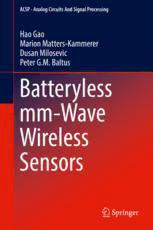
Batteryless mm-Wave Wireless Sensors PDF
Preview Batteryless mm-Wave Wireless Sensors
ACSP · Analog Circuits And Signal Processing Hao Gao Marion Matters-Kammerer Dusan Milosevic Peter G.M. Baltus Batteryless mm-Wave Wireless Sensors Analog Circuits and Signal Processing SeriesEditors: MohammedIsmail,Dublin,USA MohamadSawan,Montreal,Canada The Analog Circuits and Signal Processing book series, formerly known as the Kluwer International Series in Engineering and Computer Science, is a high level academicandprofessionalseriespublishingresearchonthedesignandapplications of analog integrated circuits and signal processing circuits and systems. Typically per year we publish between 5–15 research monographs, professional books, handbooks,editedvolumesandtextbookswithworldwidedistributiontoengineers, researchers,educators,andlibraries. The book series promotes and expedites the dissemination of new research resultsandtutorialviewsintheanalogfield.Thereisanexcitingandlargevolume ofresearchactivityinthefieldworldwide.Researchersarestrivingtobridgethegap between classical analog work and recent advances in very large scale integration (VLSI) technologies with improved analog capabilities. Analog VLSI has been recognizedasamajortechnologyforfutureinformationprocessing.Analogworkis showing signs of dramatic changes with emphasis on interdisciplinary research efforts combining device/circuit/technology issues. Consequently, new design concepts,strategiesanddesigntoolsarebeingunveiled. Topicsofinterestinclude: AnalogInterfaceCircuitsandSystems; Dataconverters; Active-RC,switched-capacitorandcontinuous-timeintegratedfilters; Mixedanalog/digitalVLSI; Simulationandmodeling,mixed-modesimulation; Analognonlinearandcomputationalcircuitsandsignalprocessing; AnalogArtificialNeuralNetworks/ArtificialIntelligence; Current-modeSignalProcessing;Computer-AidedDesign(CAD)tools; Analog Design in emerging technologies (Scalable CMOS, BiCMOS, GaAs, heterojunctionandfloatinggatetechnologies,etc.); AnalogDesignforTest; Integratedsensorsandactuators;AnalogDesignAutomation/Knowledge-based Systems;AnalogVLSIcelllibraries;Analogproductdevelopment;RFFrontends, WirelesscommunicationsandMicrowaveCircuits; Analogbehavioralmodeling,AnalogHDL. Moreinformationaboutthisseriesathttp://www.springer.com/series/7381 Hao Gao (cid:129) Marion Matters-Kammerer Dusan Milosevic (cid:129) Peter G.M. Baltus Batteryless mm-Wave Wireless Sensors 123 HaoGao MarionMatters-Kammerer EindhovenUniversityofTechnology EindhovenUniversityofTechnology Eindhoven,TheNetherlands Eindhoven,TheNetherlands DusanMilosevic PeterG.M.Baltus EindhovenUniversityofTechnology EindhovenUniversityofTechnology Eindhoven,TheNetherlands Eindhoven,TheNetherlands ISSN1872-082X ISSN2197-1854 (electronic) AnalogCircuitsandSignalProcessing ISBN978-3-319-72979-4 ISBN978-3-319-72980-0 (eBook) https://doi.org/10.1007/978-3-319-72980-0 LibraryofCongressControlNumber:2017963131 ©SpringerInternationalPublishingAG2018 Thisworkissubjecttocopyright.AllrightsarereservedbythePublisher,whetherthewholeorpartof thematerialisconcerned,specificallytherightsoftranslation,reprinting,reuseofillustrations,recitation, broadcasting,reproductiononmicrofilmsorinanyotherphysicalway,andtransmissionorinformation storageandretrieval,electronicadaptation,computersoftware,orbysimilarordissimilarmethodology nowknownorhereafterdeveloped. Theuseofgeneraldescriptivenames,registerednames,trademarks,servicemarks,etc.inthispublication doesnotimply,evenintheabsenceofaspecificstatement,thatsuchnamesareexemptfromtherelevant protectivelawsandregulationsandthereforefreeforgeneraluse. Thepublisher,theauthorsandtheeditorsaresafetoassumethattheadviceandinformationinthisbook arebelievedtobetrueandaccurateatthedateofpublication.Neitherthepublishernortheauthorsor theeditorsgiveawarranty,expressorimplied,withrespecttothematerialcontainedhereinorforany errorsoromissionsthatmayhavebeenmade.Thepublisherremainsneutralwithregardtojurisdictional claimsinpublishedmapsandinstitutionalaffiliations. Printedonacid-freepaper ThisSpringerimprintispublishedbySpringerNature TheregisteredcompanyisSpringerInternationalPublishingAG Theregisteredcompanyaddressis:Gewerbestrasse11,6330Cham,Switzerland Contents 1 Introduction .................................................................. 1 1.1 Background.............................................................. 1 1.2 ScopeoftheBook....................................................... 2 1.3 OutlineoftheBook..................................................... 3 References..................................................................... 4 2 StateoftheArt............................................................... 5 2.1 Introduction ............................................................. 5 2.2 WirelessPowerTransfer................................................ 6 2.3 mm-WaveWirelessPowerTransfer.................................... 7 2.4 TechniquesforLowPowerConsumption.............................. 7 2.5 WirelesslyPoweredSensorNode...................................... 8 2.6 Conclusion .............................................................. 9 References..................................................................... 9 3 SystemAnalysisofmm-WaveWirelessSensorNetworks............... 13 3.1 Introduction ............................................................. 13 3.2 SystemDescription ..................................................... 13 3.3 LinkBudgetCalculation................................................ 15 3.3.1 Downlink........................................................ 15 3.3.2 Uplink........................................................... 17 3.4 Conclusion .............................................................. 19 References..................................................................... 19 4 RectifierAnalysis............................................................. 21 4.1 Introduction ............................................................. 21 4.2 BasicRectifierStructure................................................ 21 4.3 RectifierPerformanceParameters...................................... 23 4.3.1 GeneralWirelessPowerSystemArchitecture................. 23 4.3.2 RectifierPerformanceParameters ............................. 24 v vi Contents 4.4 RectifierAnalysisandModeling....................................... 25 4.4.1 ModelingofRectifierwithLowInputPower ................. 26 4.4.2 ModelingofRectifierwithHighInputPower................. 33 4.5 LimitationsofRectifierModelingandChallenges.................... 37 4.5.1 RectifierModelingLimitation ................................. 37 4.5.2 mm-WaveRectifierChallenges ................................ 38 4.6 Conclusion .............................................................. 40 References..................................................................... 41 5 mm-WaveRectifiers ......................................................... 43 5.1 Introduction ............................................................. 43 5.2 MethodstoImprovethemm-WaveRectifierPerformance ........... 43 5.2.1 ThresholdVoltageModulation................................. 44 5.2.2 InductorPeaking................................................ 45 5.2.3 OutputFilter .................................................... 46 5.3 mm-WaveRectifierImplementationandMeasurement............... 47 5.3.1 Single-StageInductor-PeakedRectifierwithOutputFilter... 48 5.3.2 Multi-StageInductor-PeakedRectifierwithOutputFilter.... 50 5.3.3 50(cid:2)60GHzBroadbandRectifier............................. 53 5.4 Conclusions ............................................................. 55 References..................................................................... 57 6 mm-WaveMonolithicIntegratedSensorNodes.......................... 59 6.1 Introduction ............................................................. 59 6.2 SystemDescription ..................................................... 60 6.2.1 SystemBehaviorDescription .................................. 60 6.2.2 Two-AntennaSensorNodeSystemArchitecture ............. 61 6.2.3 One-AntennaSensorNodeSystemArchitecture.............. 62 6.2.4 ComparisonoftheTwoSolutions.............................. 62 6.3 CircuitDesign........................................................... 63 6.3.1 Multi-StageRectifierforWirelessPowerReceiver........... 63 6.3.2 End-of-BurstMonitor .......................................... 64 6.3.3 RFSwitch....................................................... 64 6.3.4 On-ChipAntenna............................................... 66 6.3.5 MatchingBetweentheRectifierandtheOn-ChipAntenna .. 67 6.3.6 TransmitterwithTemperatureSensing ........................ 69 6.4 mm-WaveSensorNodesImplementation.............................. 69 6.4.1 mm-WaveSensorNodewithTwoAntennas .................. 70 6.4.2 mm-WaveSensorNodewithOneAntenna.................... 73 6.5 Conclusion .............................................................. 74 References..................................................................... 77 7 mm-WaveLow-PowerReceiver............................................ 79 7.1 Introduction ............................................................. 79 7.2 Radio-TriggeredPassiveReceiverArchitecture....................... 80 Contents vii 7.3 EnergyModels.......................................................... 81 7.3.1 AntennaandMatchingNetwork............................... 81 7.3.2 RFRectifier ..................................................... 82 7.3.3 LNA ............................................................. 83 7.3.4 Self-mixer....................................................... 84 7.3.5 SystemLimitations ............................................. 85 7.4 SystemEvaluation ...................................................... 86 7.5 CircuitImplementationforthe60GHzUltra-Low-PowerReceiver . 87 7.5.1 60GHzInjection-LockedOscillator........................... 88 7.5.2 60GHzLowPowerDifferentialLNA......................... 90 7.5.3 60GHzPassiveMixer.......................................... 93 7.5.4 60GHzUltra-Low-PowerOOKReceiver..................... 95 7.5.5 60GHzUltra-Low-PowerOOKReceiverMeasurement ..... 95 7.6 Conclusion .............................................................. 97 References..................................................................... 99 8 mm-WaveFront-EndDesignforPhased-ArraySystems................ 101 8.1 Introduction ............................................................. 101 8.2 LinkBudgetofthe60GHzSensorNetwork .......................... 101 8.3 Phased-ArrayArchitecture ............................................. 102 8.3.1 AdvantagesofaPhased-ArrayReceiverArchitecture ....... 102 8.3.2 SignalPathPhaseShifting ..................................... 104 8.3.3 RFFront-EndandSpecification ............................... 105 8.4 60GHzLNA ............................................................ 107 8.4.1 Technology...................................................... 107 8.4.2 TopologySelection ............................................. 108 8.4.3 DesignStrategy................................................. 109 8.4.4 MeasurementResult............................................ 114 8.4.5 Conclusion ...................................................... 114 8.5 60GHz5-BitDigitallyControlledPhaseShifter...................... 115 8.5.1 PhaseShiftRealization......................................... 116 8.5.2 PhaseShifterImplementation.................................. 120 8.5.3 PhaseShiftSchematicandLayout............................. 125 8.5.4 MeasurementResultsandComparisontoState-of-the-Art... 125 8.5.5 Conclusion ...................................................... 128 8.6 Conclusion .............................................................. 129 References..................................................................... 131 9 Conclusions................................................................... 133 Index............................................................................... 135 List of Abbreviations AC Alternatingcurrent ADC Analog-to-digitalconvertor AoC Antennaonchip BAN Bodyareanetwork BER Biterrorrate BW Bandwidth CG Commongate CMOS Complementarymetaloxidesemiconductor CS Commonsource DAC Digital-to-analogconvertor DC Directcurrent EBM End-of-burstmonitor EIRP Equivalentisotropicradiationpower EVM Errorvectormagnitude FCC Federalcommunicationscommission GaAs Galliumarsenide HF Highfrequency IC Integratedcircuit IIP3 Input-referredthird-orderinterceptpoint IJLO Injectionlockedoscillator IR-UWB Impulseradioultra-wideband ISM Industrialscientificmedical LF Lowfrequency LNA Lownoiseamplifier LO Localoscillator LPF Lowpassfilter MiM Metalinsulatormetal ix x ListofAbbreviations MMID mm-Waveidentification mm-Wave Millimeterwave MoM Metaloxidemetal NEF Noiseexcessfactor NF Noisefigure OOK Onoffkeying PA Poweramplifier PREMISS Powerreducedmonolithicwirelesssensornetworks RF Radiofrequency RFID Radiofrequencyidentification RTWU Radiotriggeredwake-up Rx Receiver SiGe Silicongermanium SNR Signal-to-noiseratio SPDT Singlepoledoublethrow SPICE Simulationprogramwithintegratedcircuitemphasis SPST Signalpolesinglethrow TE Transverseelectric Tx Transmitter UHF Ultrahighfrequency ULP Ultralowpower UWB Ultrawideband VCO Voltagecontrolledoscillator VGA Variablegainamplifier WPT Wirelesspowertransfer WSN Wirelesssensornetwork WuRx Wake-upreceiver
